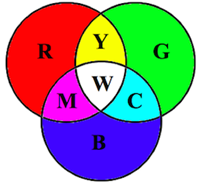Getting your Trinity Audio player ready...
Hold down the T key for 3 seconds to activate the audio accessibility mode, at which point you can click the K key to pause and resume audio. Useful for the Check Your Understanding and See Answers.
Mission LC4 Complementary Colors of Light - Question Group 1 Help

In physics, complementary colors of light are combinations of light colors that ____.

Definition of Complementary Colors:
Complementary colors of light are combinations of two light colors that can be mixed together in equal intensities to produce white light.
Complementary colors of light are combinations of two light colors that can be mixed together in equal intensities to produce white light.

 Many students of physics have seen a diagram similar to the one shown at the right. The diagram depicts three circles colored with the primary colors of light - red, green and blue. The primary colored circles overlap to produce other colors of light - known as the secondary colors of light: cyan, magenta and yellow. Complementary pairs of light colors are those colors that are exactly opposite each other on the diagram: red and cyan, magenta and green, and blue and yellow.
Many students of physics have seen a diagram similar to the one shown at the right. The diagram depicts three circles colored with the primary colors of light - red, green and blue. The primary colored circles overlap to produce other colors of light - known as the secondary colors of light: cyan, magenta and yellow. Complementary pairs of light colors are those colors that are exactly opposite each other on the diagram: red and cyan, magenta and green, and blue and yellow.